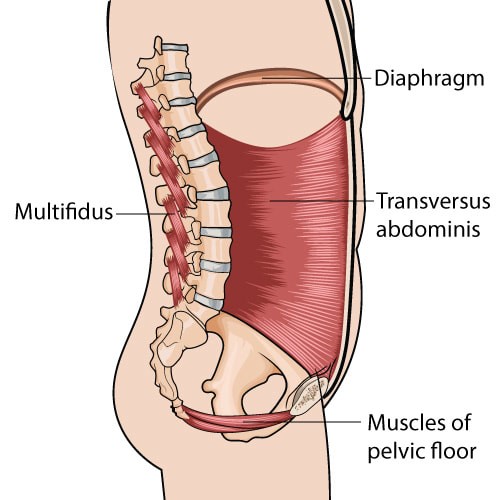What is “Core” meaning of in our human body?
The phrase “core stability” has gained popularity in the fitness and rehabilitation community in recent years, but what does it actually mean?
It’s an ability of the muscles in your abdomen, lower back, hips, and pelvis to cooperate in order to support and preserve your spine is known as core stability. This complex mechanism is essential for preventing strain and harm to our spine. Let’s dive into how core stability functions and why it’s essential for spinal health.

The main 4 core muscles are:
- Diaphragm
- Transversus Abdominis
- Multifidus
- Pelvic Floor muscle
Understanding Core Stability
Core stability involves more than just a six-pack; it encompasses a group of muscles that stabilize the spine and pelvis. These include:
- Transverse Abdominis: The deepest layer of abdominal muscles, acting like a natural corset.
- Multifidus: A group of small muscles that run along your spine.
- Pelvic Floor Muscles: These help with bladder control and pelvic stability.
- Diaphragm: The primary muscle of respiration, which also plays a role in core stability.
When these muscles are strong and functioning correctly, they create a solid foundation for movement, allowing the spine to remain aligned and protected during physical activities.
:upscale()/2024/03/20/926/n/1922729/3bf7a3f865fb51ac973d32.63344656_PS23_Fitness.jpg)
The Role of Core Stability in Spinal Protection
- Improved Posture: A strong core helps maintain proper posture, reducing the risk of slumping or hunching, which can place undue stress on the spine. Good posture aligns the spine, minimizing wear and tear on the vertebrae and intervertebral discs.
- Reduced Risk of Injury: A stable core can absorb impact and forces during activities such as running, lifting, or jumping. This absorption reduces the likelihood of straining or injuring the back during sudden movements.
- Enhanced Movement Efficiency: When your core is stable, it allows for better control of your limbs and overall movement patterns. This efficiency not only improves athletic performance but also helps prevent awkward movements that could lead to injuries.
- Spinal Alignment: Core muscles help maintain the natural curves of the spine. When these muscles are weak, the spine can become misaligned, leading to discomfort, pain, and potential injuries over time.
- Support During Daily Activities: Everyday tasks like bending, twisting, or lifting require core stability. Without it, these movements can put excessive strain on the spine, leading to chronic issues.
Here are the 3 examples of core stability exercises:
- Plank
- Start in a push-up position, but with your weight resting on your forearms instead of your hands.
- Keep your body in a straight line from head to heels, engaging your core to prevent sagging in your lower back.
- Hold this position for 20–60 seconds, focusing on maintaining stability through your core.

- Dead Bug
- Lie on your back with your arms extended straight up toward the ceiling and your knees bent at 90 degrees.
- Slowly extend your right leg and lower your left arm toward the floor, keeping your back flat on the mat.
- Return to the starting position, then repeat on the other side.
- Perform 10–12 repetitions per side, maintaining control and stability throughout.

- Bird Dog
- Start on your hands and knees, with your hands directly under your shoulders and knees under your hips.
- Slowly extend your right arm forward and left leg backward, keeping both parallel to the floor.
- Hold for a few seconds while keeping your core engaged and your back flat.
- Return to the starting position and repeat with the opposite arm and leg.
- Perform 10–12 reps per side.
- These exercises target the muscles in your core and help improve stability, balance, and overall strength.

Conclusion
Maintaining core stability is essential for improving our general physical health and safeguarding our spine. In addition to lowering our chance of injury, strengthening our core can also help us move more efficiently and with better posture. Spending time on core stability exercises is a wise choice for long-term spinal health, regardless of whether you’re an athlete or just trying to keep up a healthy lifestyle. Keep in mind that a healthy spine starts with a strong core!
References:
- Kuo DT, Tadi P. Cervical Spondylosis. [Updated 2023 May 1]. In: StatPearls [Internet]. Treasure Island (FL): StatPearls Publishing; 2024 Jan-. Available from: https://www.ncbi.nlm.nih.gov/books/NBK551557/
- Cervical spondylosis. (n.d.). Physiopedia. https://www.physio-pedia.com/Cervical_Spondylosis
Prepared by
James
Your Physio Alam Damai


